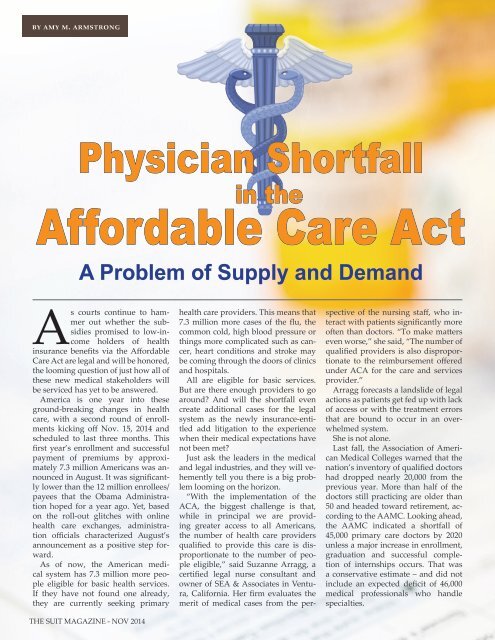One City Built to Last
The news is in: On November 7, 2014, the justices announced they would decide on a lawsuit claiming that the language of the Affordable Care Act doesn’t allow the government to provide tax-credits to low-and-moderate-income health insurance consumers using federally funded Obamacare exchanges operating in more than 30 states. Indeed, there’s a medical quagmire. And there is a lack of communication between doctors, staffing and patients. For example, the Affordable Care Act isn’t just about insurance coverage. The legislation is also about transforming the way health care is provided. In fact, it has brought in new competitors, services and business practices, which are in turn producing substantial industry shifts that affect all players along health care’s value chain. Read Amy Armstrongs story on page 16. On page 21, our reporter Judy Magness, profiles companies all over the country making incredible advances. Take a look at Functional Medicine and the driving breakthroughs in breast cancer while
The news is in: On November 7, 2014, the justices announced they would decide on a lawsuit claiming that the language of the Affordable Care Act doesn’t allow the government to provide tax-credits to low-and-moderate-income health insurance consumers using federally funded Obamacare exchanges operating in more than 30 states. Indeed, there’s a medical quagmire. And there is a lack of communication between doctors, staffing and patients. For example, the Affordable Care Act isn’t just about insurance coverage. The legislation is also about transforming the way health care is provided. In fact, it has brought in new competitors, services and business practices, which are in turn producing substantial industry shifts that affect all players along health care’s value chain. Read Amy Armstrongs story on page 16. On page 21, our reporter Judy Magness, profiles companies all over the country making incredible advances. Take a look at Functional Medicine and the driving breakthroughs in breast cancer while
You also want an ePaper? Increase the reach of your titles
YUMPU automatically turns print PDFs into web optimized ePapers that Google loves.
y amy m. armstrong<br />
Physician Shortfall<br />
in the<br />
Affordable Care Act<br />
A Problem of Supply and Demand<br />
As courts continue <strong>to</strong> hammer<br />
out whether the subsidies<br />
promised <strong>to</strong> low-income<br />
holders of health<br />
insurance benefits via the Affordable<br />
Care Act are legal and will be honored,<br />
the looming question of just how all of<br />
these new medical stakeholders will<br />
be serviced has yet <strong>to</strong> be answered.<br />
America is one year in<strong>to</strong> these<br />
ground-breaking changes in health<br />
care, with a second round of enrollments<br />
kicking off Nov. 15, 2014 and<br />
scheduled <strong>to</strong> last three months. This<br />
first year’s enrollment and successful<br />
payment of premiums by approximately<br />
7.3 million Americans was announced<br />
in August. It was significantly<br />
lower than the 12 million enrollees/<br />
payees that the Obama Administration<br />
hoped for a year ago. Yet, based<br />
on the roll-out glitches with online<br />
health care exchanges, administration<br />
officials characterized August’s<br />
announcement as a positive step forward.<br />
As of now, the American medical<br />
system has 7.3 million more people<br />
eligible for basic health services.<br />
If they have not found one already,<br />
they are currently seeking primary<br />
THE SUIT MAGAZINE - NOV 2014<br />
health care providers. This means that<br />
7.3 million more cases of the flu, the<br />
common cold, high blood pressure or<br />
things more complicated such as cancer,<br />
heart conditions and stroke may<br />
be coming through the doors of clinics<br />
and hospitals.<br />
All are eligible for basic services.<br />
But are there enough providers <strong>to</strong> go<br />
around? And will the shortfall even<br />
create additional cases for the legal<br />
system as the newly insurance-entitled<br />
add litigation <strong>to</strong> the experience<br />
when their medical expectations have<br />
not been met?<br />
Just ask the leaders in the medical<br />
and legal industries, and they will vehemently<br />
tell you there is a big problem<br />
looming on the horizon.<br />
“With the implementation of the<br />
ACA, the biggest challenge is that,<br />
while in principal we are providing<br />
greater access <strong>to</strong> all Americans,<br />
the number of health care providers<br />
qualified <strong>to</strong> provide this care is disproportionate<br />
<strong>to</strong> the number of people<br />
eligible,” said Suzanne Arragg, a<br />
certified legal nurse consultant and<br />
owner of SEA & Associates in Ventura,<br />
California. Her firm evaluates the<br />
merit of medical cases from the perspective<br />
of the nursing staff, who interact<br />
with patients significantly more<br />
often than doc<strong>to</strong>rs. “To make matters<br />
even worse,” she said, “The number of<br />
qualified providers is also disproportionate<br />
<strong>to</strong> the reimbursement offered<br />
under ACA for the care and services<br />
provider.”<br />
Arragg forecasts a landslide of legal<br />
actions as patients get fed up with lack<br />
of access or with the treatment errors<br />
that are bound <strong>to</strong> occur in an overwhelmed<br />
system.<br />
She is not alone.<br />
<strong>Last</strong> fall, the Association of American<br />
Medical Colleges warned that the<br />
nation’s inven<strong>to</strong>ry of qualified doc<strong>to</strong>rs<br />
had dropped nearly 20,000 from the<br />
previous year. More than half of the<br />
doc<strong>to</strong>rs still practicing are older than<br />
50 and headed <strong>to</strong>ward retirement, according<br />
<strong>to</strong> the AAMC. Looking ahead,<br />
the AAMC indicated a shortfall of<br />
45,000 primary care doc<strong>to</strong>rs by 2020<br />
unless a major increase in enrollment,<br />
graduation and successful completion<br />
of internships occurs. That was<br />
a conservative estimate – and did not<br />
include an expected deficit of 46,000<br />
medical professionals who handle<br />
specialties.










